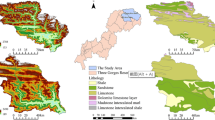Abstract
Xichou County of Wenshan Zhuang and Miao Autonomous Prefecture in southeast Yunnan is one of the karst mountainous areas in southwest China showing typical rock desertification. During this study, we set up three soil erosion contrast test spots at Muzhe Village, Benggu Township, Xichou County, which was the birthplace of the Xichou rock-desertified land consolidation mode. The three spots included the terrace land spot (already consolidated land), sloping land spot (unconsolidated sloping land under rock desertification), and standard runoff spot (bare land spot). In 2007, a whole-year complete observation was conducted during the rainy season and “rainfall-erosion” data were obtained for 32 times. Our analysis showed that during the entire observation period, the number of the rainfalls that led to soil erosion accounted for 34.04% of the number of all rainfalls and the amount of the rainfalls that led to soil erosion accounted for 84.17% of the total amount of all rainfalls. The average erosive rainfall standard in the three test spots was 11.0 mm, slightly higher than the 10 mm standard that has been adopted all over China, but lower than the 12.7 mm standard of the US and the 13.0 mm standard of Japan. According to single-factor analysis, the soil loss in the sloping land spot (L 2 ) and that in the bare land spot (L 3 ) are correlated to certain extent to many other factors, including the single precipitation (P), rainfall intensity during the maximum ten minutes (I 10 ), rainfall intensity during the maximum 20 minutes (I 20 ), rainfall intensity during the maximum 30 minutes (I 30 ), rainfall intensity during the maximum 40 minutes (I 40 ), and rainfall intensity during the maximum 60 minutes (I 60 ). Among these factors, they are of the highest relativity with I60. According to double-factor analysis, both L2 and L3 are of good relativity with P and I 60 . According to multi-factor analysis, L 2 and L 3 are also of good relativity with seven rainfall indexes, namely, P, Ia (average rainfall intensity), I 10 , I 20 , I 30 , I 40 , and I 60 , with their related coefficient R reaching 0.906 and 0.914, respectively. The annual soil losses in the three test spots are widely different: 1030.70 t/km2·a in the terrace land spot, which indicates a low-level erosion; 12913.22 t/km2·a in the sloping land spot (unconsolidated spot), some 12.5 times than that in the terrace land spot, which indicates an ultra-high-level erosion; and 19511.67 t/km2·a in the bare land spot, some 18.9 times than that in terrace land spot, indicating an acute erosion. These figures fully show that the Xichou rock-desertified land consolidation mode plays a significant role in soil conservation.
Similar content being viewed by others
References
Department of Rural Issues of the CPC Committee of Yunnan Province (DRIYP), and Department of Rural Issues of the CPC Committee of Wenshan Prefecture, Yunnan Province (DRIWP). 1997. The road leading from being poverty-stricken to being well-off: Methodology and experience of Benggu Township, Xichou County in poverty-alleviation. In: Yunnan Provincial Association of Ecological Control and Development for Karst Areas ed. Study of strategy for the development of karst areas. Kunming, China: Yunnan Science & Technology Press. Pp. 136–139. (In Chinese)
Ministry of Water Resources of China. 1997. SL190-60: Standards for classification and gradation of soil erosion. Beijing: Water Resources & Hydropower Press of China: 2–26. (In Chinese)
Renard, K. G., Foster G.R., Weesies G. A., et al. 1997. Predicting Soil Erosion by Water: A guide to conservation planning with the Revised Universal Soil Loss Equation (RUSLE). Agriculture handbook, USDA: 703.
The Chinese Academy of Sciences. 2003. Some propositions on advancing the comprehensive control of karst mountain areas in southeast China. Advance in Earth Sciences,18(4): 489–492. (In Chinese)
Wang Wanzhong. 1984. Study on the correlation between III rainfall characteristics and soil loss: On standard of erosive rainfall. Bulletin of Soil and Water Conservation4(2): 58–62. (In Chinese)
Wang Wanzhong, Jiao Juying. 1996. Quantitative evaluation on factors influencing soil erosion in China. Bulletin of Soil and Water Conservation16(5): 1–19. (In Chinese)
Wischmeier W. H, Smith D D. 1978. Predicting rainfall erosion losses: a guide to conservation planning. Agriculture handbook, USDA: 537.
Xiang Xiang. 2001. “Waiting won’t do; hope stems from action”: Investigation and study of the measures for shaking off poverty and becoming rich in rural area of Xichou County, Yunnan Province. Inquiry Into Economic Problems (2): 19–29. (In Chinese)
Xie Yun, Liu Baoyuan, Zhang Wenbo. 2000. Study on standard of erosive rainfall. Journal of Soil and Water Conservation 14(4): 6–11. (In Chinese)
Yang Zisheng. 1999. The test of soil and water loss of the sloping cultivated land in the northeast mountain region of Yunnan Province. Journal of Mountain Science, 17(Supplement): 6–9. (In Chinese)
Yang Zisheng, Liu Yansui, Bao Guangjing, et al. 2006. Rehabilitation and sustainable use pattern of rocky-desertified land in southwest China’s poverty-stricken karst mountainous areas: A case study in Benggu Township, Xichou County, Yunnan, China. Journal of Mountain Science 3(3): 237–246.
Yang Zisheng, Tao Wenxing, He Yimei, et al. 2008. The pattern of rocky-desertified land renovation and rural poverty alleviation in southwest China’s karst mountainous areas: a case study in Xichou County, Yunnan Province. In: Liu Yansui ed. Research on Sustainable Use of Land Resources and New Countryside Construction in China. Chongqin, China: Southeast China Normal University Press. Pp. 402–403.
Author information
Authors and Affiliations
Corresponding author
Rights and permissions
About this article
Cite this article
Yang, Z., Yang, L. & Zhang, B. Soil erosion and its basic characteristics at karst rocky-desertified land consolidation area: A case study at Muzhe Village of Xichou County in Southeast Yunnan, China. J. Mt. Sci. 7, 55–72 (2010). https://doi.org/10.1007/s11629-010-1047-x
Received:
Accepted:
Published:
Issue Date:
DOI: https://doi.org/10.1007/s11629-010-1047-x



